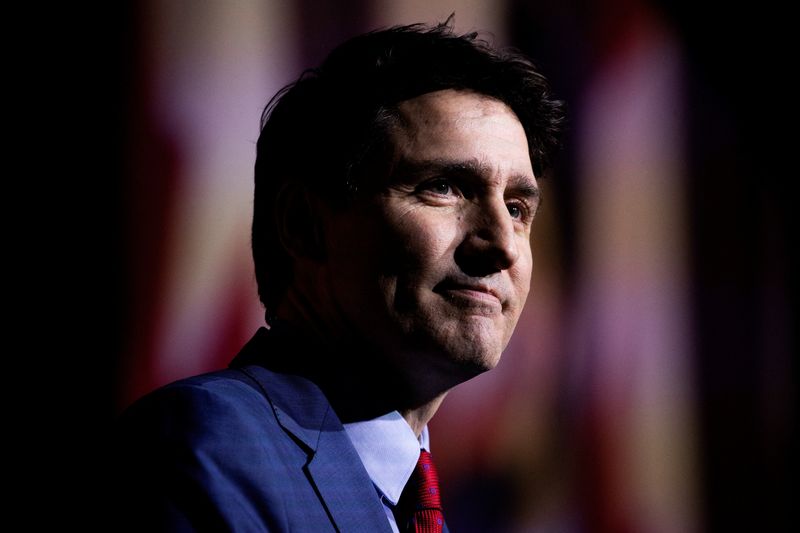Canadian politics and its economy are in the spotlight following Prime Minister Justin Trudeau’s resignation and escalating tensions with the United States.
During his tenure, Canada faced stagnating productivity, rising household debt, and growing public dissatisfaction.
Critics argue that Trudeau’s policies failed to address the country’s long-term economic challenges.
Now, with political uncertainty at an all-time high, Canada must reckon with the economic toll of his leadership.
What does Trudeau’s resignation mean for Canada?
On January 6, Trudeau announced he would step down as party leader but remain prime minister until a new leader is elected, likely by late March.
This decision follows years of declining popularity, marked by political scandals, a struggling economy, and criticism of his immigration and fiscal policies.
Recent polls place Liberal Party support at a record-low 20%, trailing the opposition Conservative Party by 24 points.
Trudeau’s resignation comes during a time of growing dissatisfaction with his leadership.
Scandals, including past blackface incidents and a 2019 corruption case, have marred his tenure.
Economic challenges, such as rising household debt, stagnant productivity, and high inflation, further damaged his public approval.
The Liberal Party is now in transition. A new leader must be chosen by late March, as parliament is prorogued until then. This political vacuum leaves Canada vulnerable as critical decisions on trade and economic policy loom.
Canada’s economic challenges
Canada’s economic woes extend beyond its political challenges. The country has faced decades of stagnating productivity growth and declining business investment.
Canada’s per-capita gross domestic product (GDP) has contracted for the past six consecutive quarters, falling 3.5% since its peak in 2022. This decline is unprecedented outside of a recession.
While oil remains a cornerstone of the economy, accounting for over 6% of GDP and 20.9% of exports in 2022, the non-oil sector has struggled to compete globally.
RBC’s recent report cites regulatory inefficiencies, inter-provincial trade barriers, and red tape as key obstacles to business growth.
Canada’s response to these issues has been inconsistent. Trudeau’s administration implemented progressive immigration policies, dramatically increasing the intake of temporary workers and foreign students.
However, critics argue that this influx has strained housing and infrastructure without significantly improving productivity.
A September 2024 Environics poll revealed that for the first time in 25 years, a majority of Canadians believe immigration levels are too high.
Many Canadians attribute the recent housing shortages and rising rent prices to an excessive and unnecessary immigration policy.
Public sentiment is at its lowest point. In fact, around 60% of Canadians believe the economy is worsening.
Declining consumer confidence is never good, neither for the economy nor for the party in leadership.
US trade threats heighten tensions
Donald Trump has intensified rhetoric against Canada, threatening substantial tariffs on Canadian goods.
Trump also made comments about Canada becoming the 51st US state.
While likely political posturing, his remarks underline strained relations between the two nations.
The US is Canada’s largest trading partner, with $2.5 billion in goods and services crossing the border daily in 2023.
Key sectors like oil, lumber, and automotive manufacturing are deeply integrated between the two economies.
Trump’s threat of a 25% tariff on Canadian imports could have devastating effects, particularly in export-heavy provinces like Ontario, which alone accounts for $350 billion in trade with the US annually.
Trump claims the US “subsidises” Canada by $200 billion annually, though US Census Bureau data shows a 2023 trade deficit of $64 billion.
A proposed 25% tariff on Canadian goods would heavily impact industries like energy, automotive, and agriculture.
Canada’s retaliation options include export taxes on vital resources like uranium, oil, and potash, which the US depends on for nuclear power and agriculture.
The Canadian dollar has weakened, trading at $0.692 USD, following Trump’s tariff threats.
Businesses are delaying investments and hiring decisions, waiting for clarity on Canada’s political and economic future.
The economic toll of uncertainty
Trudeau’s resignation has left a leadership vacuum at a critical moment.
The Liberal Party must elect a leader capable of addressing Canada’s mounting challenges while preparing for an election that could usher in a Conservative government led by Pierre Poilievre.
Poilievre has criticized Trudeau’s economic policies and vowed to prioritize productivity and innovation if elected.
Economic policy uncertainty in Canada has surged to its highest level since the early COVID-19 pandemic.
Bloomberg’s Canada Economic Policy Uncertainty Index reached 650, far exceeding the 200-350 range seen in recent decades.
Source: realeconomy
The political uncertainty has also delayed policymaking. Canada’s parliament is prorogued until March 24, effectively pausing legislative activities. This leaves little time for the new Liberal leader to implement reforms before the election.
Canada’s political and economic future
Canada’s political instability and economic challenges coincide with escalating tensions with its largest trading partner.
For the Liberal Party, the leadership race will shape the party’s direction and the country’s economic policy.
Canada’s response to Trump’s trade threats will test its economic resilience and diplomatic strategy.
With retaliatory measures on the table and internal reforms overdue, the next government faces the dual challenge of defending national interests while addressing long-term economic stagnation.
The coming months will determine whether Canada can stabilize its economy, rebuild investor confidence, and maintain its sovereignty in the face of external pressures.
